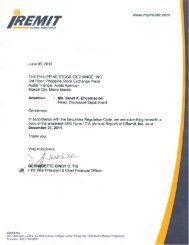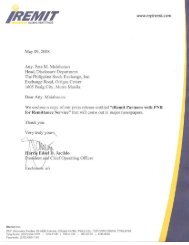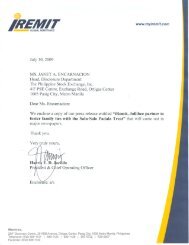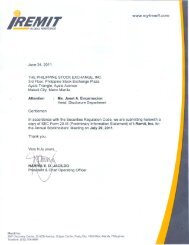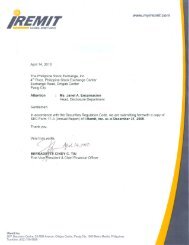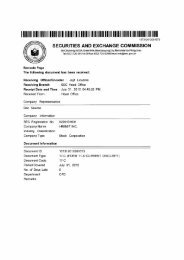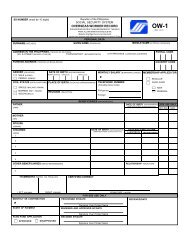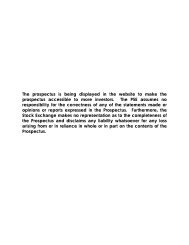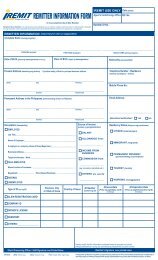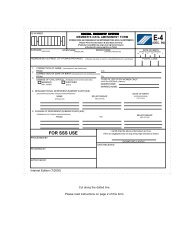SEC Form 20-IS - iRemit Global Remittance
SEC Form 20-IS - iRemit Global Remittance
SEC Form 20-IS - iRemit Global Remittance
Create successful ePaper yourself
Turn your PDF publications into a flip-book with our unique Google optimized e-Paper software.
- 13 -<br />
Gains or losses arising from the derecognition of an intangible asset are measured as the difference<br />
between the net disposal proceeds and the carrying amount of the asset and are recognized in the<br />
consolidated statement of income when the asset is derecognized.<br />
Software costs<br />
Software costs are carried at cost less accumulated amortization and any impairment in value. The<br />
cost of the asset is the amount of cash or cash equivalents paid or the fair value of the other<br />
considerations given up to acquire the asset at the time of its acquisition or production. Software<br />
costs are amortized on a straight-line basis over the estimated useful life of three (3) years.<br />
Goodwill<br />
Any excess of the acquisition cost over the fair values of the identifiable net assets acquired is<br />
recognized as goodwill. Goodwill represents the excess of the acquisition cost over the fair value<br />
of their identifiable net assets at the date of acquisition of IRCL, IGRL, IAPL, LSML and WEPL<br />
(see Note 13). Following initial recognition, goodwill is measured at cost less any accumulated<br />
impairment losses. Goodwill is reviewed for impairment annually (see accounting policy on<br />
Impairment of Nonfinancial Assets).<br />
Impairment of Nonfinancial assets<br />
Investments in associates<br />
The Group assesses at each balance sheet date whether there is any indication that its investments<br />
in associates may be impaired. If any indication exists, the Group estimates the asset’s<br />
recoverable amount. An asset’s recoverable amount is the higher of an asset’s or CGU’s fair value<br />
less cost to sell and its value in use. Where the carrying amount of an asset or CGU exceeds its<br />
recoverable amount, the asset is considered impaired and is written down to its recoverable<br />
amount.<br />
Property and equipment and software costs<br />
At each balance sheet date, the Group assesses whether there is any indication that its property and<br />
equipment and software costs may be impaired. When an indicator of impairment exists or when<br />
an annual impairment testing for an asset is required, the Group makes a formal estimate of<br />
recoverable amount. Recoverable amount is the higher of an asset’s fair value less costs to sell and<br />
its value in use and is determined for an individual asset, unless the asset does not generate cash<br />
inflows that are largely independent of those from other assets or groups of assets, in which case<br />
the recoverable amount is assessed as part of the CGU to which it belongs. Where the carrying<br />
amount of an asset (or CGU) exceeds its recoverable amount, the asset (or CGU) is considered<br />
impaired and is written down to its recoverable amount. In assessing value in use, the estimated<br />
future cash flows are discounted to their present value using a pre-tax discount rate that reflects<br />
current market assessments of the time value of money and the risks specific to the asset (or<br />
CGU). In determining fair value less cost to sell, recent market transactions are taken into<br />
account, if available. If no such transactions can be identified, an appropriate evaluation model is<br />
used. These calculations are corroborated with available fair value indicators.<br />
An impairment loss is charged to operations in the year in which it arises, unless the asset is<br />
carried at a revalued amount, in which case the impairment loss is charged to the revaluation<br />
increment of the said asset.<br />
An assessment is made at each balance sheet date as to whether there is any indication that<br />
previously recognized impairment losses may no longer exist or may have decreased. If such<br />
indication exists, the recoverable amount is estimated. A previously recognized impairment loss is<br />
reversed only if there has been a change in the estimates used to determine the asset’s recoverable<br />
*SGVMC116502*



